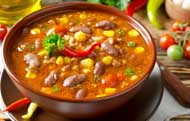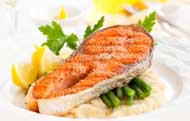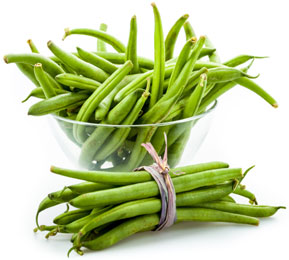





1. Bean Facts
2, Types of Beans
3. Beans Nutritional Value
4. Bean Health Benefits
The common bean also known as the "green bean" or "snap bean" (Phaseolus vulgaris) is grown worldwide. The term 'bean' initially referred to the seed of the Broad or Fava bean, is now referred to many different species of edible legumes.
Beans have been used around the world for thousands of years. They come in many shapes, sizes and colours. They are very versatile as they can be dried and stored for years, eaten raw, cooked, ground into flour, fermented into soya sauce and are excellent in soups and salads. Beans are high in fiber, soluble fiber, iron, protein, folate and complex carbohydrates.
History and Origin
Research indicates that beans were among one of the first cultivated crops throughout many countries, the earliest being in the Middle East, dating back as far as 10,000 years ago. Beans are grown on all continents except Antarctica. Brazil and India are the major produces of dry beans, whilst China is highest distributor of the green bean. There are currently about 40,000 bean varieties world wide, however only a fraction are mass produced for consumption.
- • Broad Bean (Fava bean)
- • Lentils
- • Soyabean
- • Green Bean (Common)
- • Lima Bean (Butter bean)
- • Runner Bean
- • Kidney Bean (Common)
- • Black Bean (Common)
- • Adzuki Bean
- • Mung Bean
- • Ricebean
- • Pinto Bean (Common)
Vegetables " Beans " ( Nutritional value )
Nutritional value per 100 g
Beans, snap, green, cooked, boiled, drained, without salt
|
Nutrient ( Proximate's )
|
Unit
|
Value
|
Daily Value %
|
|
Energy
|
kcal
|
35
|
1.7%
|
|
Protein
|
g
|
1.89
|
3.7%
|
|
Total lipid (fat)
|
g
|
0.28
|
0.3%
|
|
Carbohydrate, by difference
|
g
|
7.88
|
2.8%
|
|
Fiber, total dietary
|
g
|
3.2
|
11.4%
|
|
Sugars, total
|
g
|
3.63
|
|
|
Minerals
|
|||
|
Calcium, Ca
|
mg
|
44
|
3.3%
|
|
Iron, Fe
|
mg
|
0.65
|
3.6%
|
|
Magnesium, Mg
|
mg
|
18
|
4.2%
|
|
Phosphorus, P
|
mg
|
29
|
2.3%
|
|
Potassium, K
|
mg
|
146
|
3.1%
|
|
Sodium, Na
|
mg
|
1
|
0.0004%
|
|
Zinc, Zn
|
mg
|
0.25
|
2.2%
|
|
Copper, Cu
|
mg
|
0.057
|
6.3%
|
|
Manganese, Mn
|
mg
|
0.285
|
12.3%
|
|
Selenium, Se
|
mcg
|
0.2
|
0.3%
|
|
Vitamins
|
|||
|
Vitamin C, total ascorbic acid
|
mg
|
9.7
|
10.7%
|
|
Thiamin (B-1)
|
mg
|
0.074
|
6.1%
|
|
Riboflavin (B-2)
|
mg
|
0.097
|
7.4%
|
|
Niacin NE (niacin) (B-3)
|
mg
|
0.614
|
3.8%
|
|
Pantothenic acid (B-5)
|
mg
|
0.074
|
1.4%
|
|
Vitamin (B-6)
|
mg
|
0.056
|
3.2%
|
|
Folate DFE (dietary folate) (B-9)
|
mcg
|
33
|
8.2%
|
|
Vitamin B-12
|
mcg
|
0.00
|
|
|
Vitamin A, RAE (retinol)
|
mcg
|
32
|
3.5%
|
|
Vitamin E (alpha-tocopherol)
|
mg
|
0.46
|
3%
|
|
Vitamin D (D2 + D3)
|
mcg
|
0
|
|
|
Vitamin K (phylloquinone)
|
mcg
|
47.9
|
39.9%
|
|
Lipids
|
|||
|
Saturated Fatty Acids
|
g
|
0.064
|
|
|
Monounsaturated Fatty Acids
|
g
|
0.011
|
|
|
Polyunsaturated Fatty Acids
|
g
|
0.145
|
|
|
Trans Fatty Acids
|
g
|
0.000
|
|
|
Carotenoids
|
|||
|
Beta-Carotene
|
mcg
|
380
|
|
|
Lutein + zeaxanthin
|
mcg
|
641
|
|
|
Lycopene
|
mcg
|
0
|
|

|
Reference Values are based on a 2,000 Calorie Intake, for Adults and Children 4 or More Years of Age. Your daily values may be higher or lower depending on your calorie needs.
|
|
Percentages are roughly approximated using (RDA) Recommended Dietary Allowances for adults. Source: USDA United States Department of Agriculture
|
|
Reference Values for Nutrition - FDA U.S. Food and Drug Administration
|
Bean Nutritional Value
Beans differ in size, colour and shape, however it appears their nutritional value is similar
Beans differ in size, colour and shape; however it appears their nutritional value is similar. They are high in protein, carbohydrates, vitamins and minerals, and are low in fat. Beans are a rich source of dietary fibre, which acts as a laxative and protects the colon of toxic substances. Adequate amounts of fiber has been shown to reduce blood cholesterol levels.
Studies indicate that beans are high in lignans which may assist with the prevention of osteoporosis, heart disease and some cancers. It is thought that flavonoids in beans may also reduce heart disease. The complex carbohydrates in beans, is thought to assist with insulin resistance, which is great for diabetes.
Beans are high in both soluble and insoluble fiber. Soluble fibre helps lower blood cholesterol, whilst insoluble fibre attracts water to the stool and enhances waste transit time through the colon, thus assisting with constipation, colon cancer and other digestive tract conditions.
Research indicates that Zea-xanthin, a dietary carotenoid in beans, offers some protection in the prevention of age-related macular disease in older people.
Beans have been found to be low in fat, high in fiber and packed with protein. They provide a rich source of vitamins and minerals as well as phytochemicals. They are a rich source of iron, which makes them ideal for vegans.
- HEART DISEASE
Rich in flavonoids - DIABETES & HYPERLIPIDEMIA
Complex Carbohydrates assist with insulin resistance - COLON CANCER
High in insoluble fiber - RICH IN LIGNANS
Helps prevent osteoporosis - RICH SOURCE OF IRON
Ideal for vegans

- BLOOD CHOLESTEROL
Phytosterols contained in beans - CONSTIPATION
High in insoluble fiber - OBESITY
Low in fat, high in fiber - DIETARY FIBRE
Acts as a bulk laxative - ZEA-XANTHIN (Carotenoid)
Prevents age-related macular disease
References
Nutrient Database - USDA (United States Department of Agriculture)
Reference Values for Nutrition – FDA (U.S. Food and Drug Administration)
The Bean Institute - is owned and managed by the Northarvest Bean Growers Association USA
